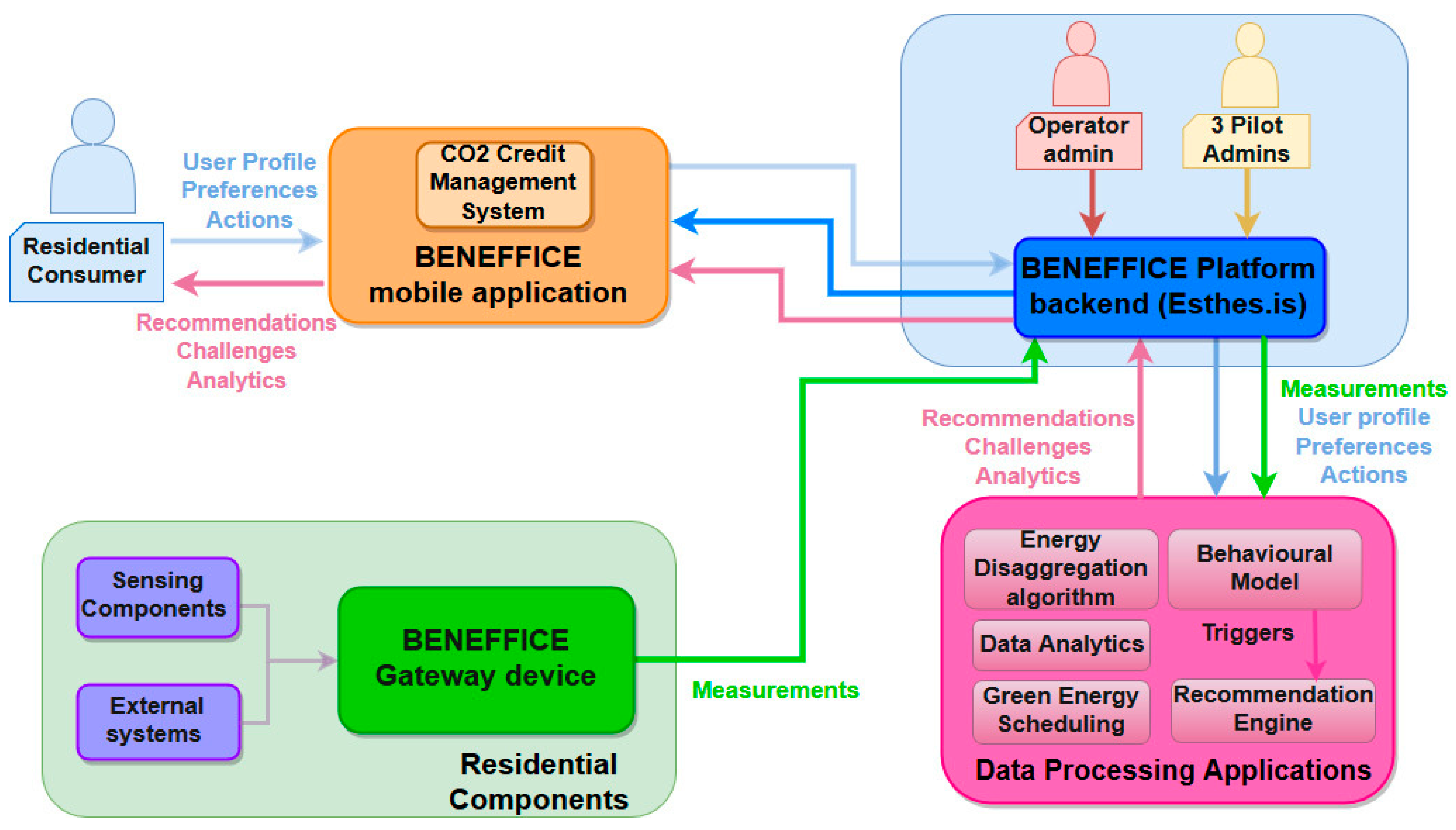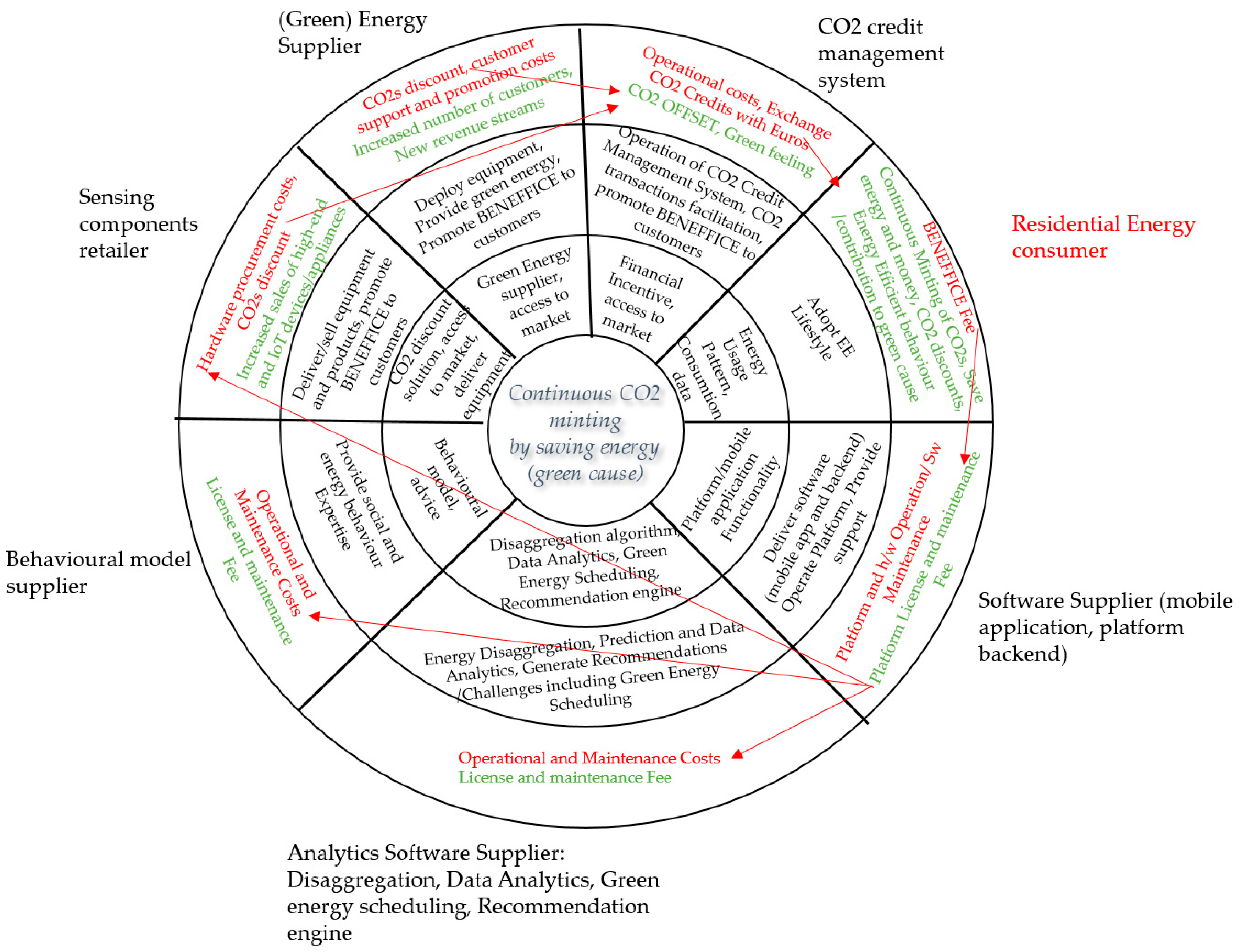BENEFFICE: Behaviour Change, Consumption Monitoring and Analytics with Complementary Currency Rewards †
Abstract
:1. Introduction
2. BENEFFICE System Architecture and Design
- Residential Components: These consist of:
- The sensing components (Internet of Things devices) to be installed in the consumers’ residences and measure: the total energy consumption of the residence, the indoor temperature and the gas consumption related to heating.
- The external systems that provide additional data and measurements namely the region climate conditions and the Energy production from Renewable Energy Sources (where available).
- The BENEFFICE gateway device to be installed in each residence in order to collect and forward all measurements to the backend for storage and further processing.
- BENEFFICE platform backend (Esthes.is): This is a multi service platform which handles the data collection of the sensing components and the external systems through the gateway device and is responsible to store the data, to manage the deployed residential gateways and to provide APIs access to all the other Data Processing Applications. In addition, the platform backend is responsible to store the consumer’s input (i.e. profile, preferences, energy consumption related behaviour etc.) and also sent the outcomes of the Data Processing Applications (i.e. disagreggation results, recommendations, challenges, notifications etc.) for display to the BENEFFICE mobile application.
- Data Processing Applications: these include all BENEFFICE modules which consume /process data that are stored in the platform back end (obtained from the sensing components, the external systems or provided by the consumer). These are the Energy Disaggregation algorithm, the Data Analytics, the Behavioural model, the Recommendation Engine and the Green energy scheduling.
- The BENEFFICE mobile application is the main interface that the residential consumers use in order to interact with the BENEFFICE platform. It collects the consumers’ input (i.e. information about their energy consumption behaviour, preferences or actions) and send it to the platform backend to be stored. It also displays energy measurements, disaggregation results, recommendations, challenges and earned CO2 credits to the consumers. The CO2 credit management system enables the circulation of the CO2 currency within the BENEFFICE ecosystem.
3. BENEFFICE Components Description
4. BENEFFICE Business Models and Ecosystem
5. Conclusions
Author Contributions
Funding
Conflicts of Interest
References
- Gillingham, K.; Rapson, D.; Wagner, G. The rebound effect and energy efficiency policy. Rev. Environ. Economics Policy 2016, 10, 68–88. [Google Scholar] [CrossRef]
- Vivanco, D.F.; Kemp, R.; Van Der Voet, E. How to deal with the rebound effect? A policy-oriented approach. Energy Policy 2016, 94, 114–125. [Google Scholar] [CrossRef]
- European Comission website. Available online: https://ec.europa.eu/clima/policies/international/negotiations/paris/index_en.htm (accessed on 24 April 2019).
- Rogelj, J.; Elzen, M.D.; Höhne, N.; Fransen, T.; Fekete, H.; Winkler, H.; Schaeffer, R.; Sha, F.; Riahi, K.; Meinshausen, M. Paris Agreement climate proposals need a boost to keep warming well below 2 °C. Nature 2016, 534, 631–639. [Google Scholar] [CrossRef] [PubMed]
- European Comission website, COM (2013) 7243 final. Available online: https://ec.europa.eu/energy/sites/ener/files/documents/com_2013_public_intervention_en.pdf (accessed on 24 April 2019).
- Yu, Z.; Fung, B.C.M.; Haghighat, F.; Yoshino, H.; Morofsky, E. A systematic procedure to study the influence of occupant behaviour on building energy consumption. Energy Build. 2011, 43, 1409–1417. [Google Scholar] [CrossRef]
- European Comission website, COM (2016)51 final. Available online: https://ec.europa.eu/transparency/regdoc/rep/1/2016/EN/1-2016-51-EN-F1-1.PDF (accessed on 24 April 2019).
- Reinaud, J.; Clinckx, N.; Ronzeau, K.; Faraggi, P. Scaling Up Innovation in the Energy Union to Meet New Climate, Competitiveness and Societal Goals; Industrial Innovation for Competitiveness (i24c): Brussels, Belgium, 2016. [Google Scholar]
- Dufour, M.; Skillings, J.; Gaventa, J. Rebooting Europe’s Energy Leadership. E3G briefing paper. 2016. Available online: https://www.e3g.org/docs/E3G_Brief_-_Consumer-focused_energy_innovation_%28Apr_2016%29.pdf (accessed on 24 April 2019).
- European Comission website. Press releases. Available online: http://europa.eu/rapid/press-release_IP-16-4009_en.htm (accessed on 24 April 2019).
- SmartSpaces project, ICT-PSP. Available online: http://source.smartspaces.eu/30_StakeholderFocused/st.html (accessed on 24 April 2019).
- Behaviour Change and Energy Use; Cabinet Office Behavioural Insights Team: Westminster, UK, 2011.
- Erhardt-Martinez, K.; Donelly, K.A.; Laitner, J.A. Advanced Metering Initiatives and Residential Feedback Programs: A meta-review for household energy-saving opportunities; Report Number E105; American Council for an Energy-Efficient Economy: Washington, DC, USA, 2010. [Google Scholar]
- Gynther, L.; Eichhammer, W. Energy Efficiency and the Public Sector; Odyssee-Mure Project; Pan European: Brussels, Belgium, 2016. [Google Scholar]
- Kaselimi, M.; Doulamis, N.; Doulamis, A.; Voulodimos, A.S.; Protopapadakis, E. Bayesian-Optimized Bidirectional LSTM Regression Model for Non-Intrusive Load Monitoring. In ICASSP 2019—2019 IEEE International Conference on Acoustics, Speech and Signal Processing (ICASSP), Brighton, UK, 12–17 May 2019; IEEE: New York, NY, USA, 2019; pp. 2747–2751. [Google Scholar]
- Grefen, P. Service-Dominant Business Engineering with BASE/X: Business Modelling Handbook; CreateSpace Independent Publishing Platform: Scotts Valley, CA, USA, 2015; ISBN/ISSN 978-1516942176. [Google Scholar]


| Service | BENEFFICE offers a minting CO2 service to incentivize long term energy efficient behavior and is providing services to help consumers to reduce their energy/electricity consumption. It is offered jointly by traditional (utility) and new players in the energy market that act as catalysts for the adoption of BENEFFICE solution and benefit from it. Each consumer could become a “hero” of climate change by continuously minting CO2s, saving energy and contributing to this green cause. |
| Value Proposition | The software supplier acts as a data broker which collects data from the sensing components, external systems and gateway. It offers the united BENEFFICE service that gathers, stores and makes available all data to the data processing applications. Moreover, the mobile application enables the interaction with the residential consumers. |
| Co-production activity | Software delivery (BENEFFICE platform and mobile app) and integration. Operation and maintenance of the platform |
| Cost (−)/ benefit (+) | (−) development, maintenance, operation and technical support costs (+) license and maintenance fees |
| Value Proposition | Offers the services of Energy Disaggregation and data analytics, implements the recommendation engine and the green energy scheduling modules. |
| Co-production activity | Software analytics delivery |
| Cost (−)/ benefit (+) | (−) development, maintenance, operation and technical support costs (+) license and maintenance fees |
| Value Proposition | Delivery of the multifactorial behavioural model and advice on how to organise the communication with the residential consumers (recommendation engine). |
| Co-production activity | Based on the expertise in social aspects and energy behavior: creation and update of the multifactorial behavioural model, identification of segments of residential consumers and provision of advice on the communication with each segment in order to achieve the maximum engagement. |
| Cost (−)/ benefit (+) | (−) development, maintenance, operation and technical support costs (+) license and maintenance fees |
| Value Proposition | Delivers the equipment (sensors, meters, gateway, hardware), Offers CO2 discount to the residential consumers for certain products (as BENEFFICE ecosystem stakeholder) Contributes its customers (to increase the BENEFFICE market penetration) |
| Co-production activity | Promoting and selling the BENEFFICE product in its stores and provision of further advice on how to be more energy efficient (for example the residential consumer will be advised to buy appliances with optimum energy consumption using the CO2 discount). |
| Cost (−)/ benefit (+) | (−) Hardware procurement costs, CO2 discount (+) Increased sales of high-end and Internet of Things devices/appliances |
| Value Proposition | Offers green energy Contributes its customers (to increase the BENEFFICE market penetration) |
| Co-production activity | Assist with the deployment of the equipment (meters, sensors, gateway, hardware) in the residential consumers and promote BENEFFICE product in its customers. |
| Cost (−)/ benefit (+) | (−) CO2 discount, Customer support costs, Promotion costs (+) Increased number of customers, new revenue streams |
| Value Proposition | Operates the CO2 credit management system Facilitates the CO2 transactions enabling the CO2s to Euros exchange Contributes its customers (to increase the BENEFFICE market penetration) |
| Co-production activity | Development and Operation of the CO2 credit management system (neobanking application), Balance maintenance of CO2 Credits, CO2 credits transactions facilitation, promotion of BENEFFICE to its customers. |
| Cost (−)/ benefit (+) | (−) Operational costs, Exchange costs (CO2 credits with Euros and vice versa) (+) CO2 offset, CO2 circulation/transactions, engagement of new consumers to CO2s (possible new customers), leading role in the formulation of a new ecosystem, Contribution to the fight for climate change |
| Value Proposition | Residential energy consumers offer their energy usage pattern and energy consumption measurements for further analysis and training of the disaggregation algorithm and the behavioural model. |
| Co-production activity | Residential energy consumers can adapt their lifestyle for a green cause, adopt a more energy efficient behaviour, save energy and money and earn CO2 credits. |
| Cost (−)/ benefit (+) | (−) BENEFFICE fee (+) CO2s credits earned by adopting proposed recommendations and challenges, energy and money savings (reduced energy bills), CO2 discounts, energy efficient behavior/ Contribution to a green cause |
Publisher’s Note: MDPI stays neutral with regard to jurisdictional claims in published maps and institutional affiliations. |
© 2019 by the authors. Licensee MDPI, Basel, Switzerland. This article is an open access article distributed under the terms and conditions of the Creative Commons Attribution (CC BY) license (https://creativecommons.org/licenses/by/4.0/).
Share and Cite
Garbi, A.; Malamou, A.; Michas, N.; Pontikas, Z.; Doulamis, N.; Protopapadakis, E.; Mikkelsen, T.N.; Kanellakis, K.; Baradat, J.-L. BENEFFICE: Behaviour Change, Consumption Monitoring and Analytics with Complementary Currency Rewards. Proceedings 2019, 20, 12. https://doi.org/10.3390/proceedings2019020012
Garbi A, Malamou A, Michas N, Pontikas Z, Doulamis N, Protopapadakis E, Mikkelsen TN, Kanellakis K, Baradat J-L. BENEFFICE: Behaviour Change, Consumption Monitoring and Analytics with Complementary Currency Rewards. Proceedings. 2019; 20(1):12. https://doi.org/10.3390/proceedings2019020012
Chicago/Turabian StyleGarbi, Anastasia, Anna Malamou, Nassos Michas, Zisis Pontikas, Nikolaos Doulamis, Eftychios Protopapadakis, Thomas N. Mikkelsen, Konstantinos Kanellakis, and Jean-Luc Baradat. 2019. "BENEFFICE: Behaviour Change, Consumption Monitoring and Analytics with Complementary Currency Rewards" Proceedings 20, no. 1: 12. https://doi.org/10.3390/proceedings2019020012
APA StyleGarbi, A., Malamou, A., Michas, N., Pontikas, Z., Doulamis, N., Protopapadakis, E., Mikkelsen, T. N., Kanellakis, K., & Baradat, J.-L. (2019). BENEFFICE: Behaviour Change, Consumption Monitoring and Analytics with Complementary Currency Rewards. Proceedings, 20(1), 12. https://doi.org/10.3390/proceedings2019020012






